Are AFL clubs getting a fair deal when it comes to off-field finances?By Cody Atkinson and Sean Lawson
ABC
14 April 2022Footy clubs compete for premiership points on the field each week, but some of their toughest battles are fought off it.
The race for members and revenue is intense. The AFL administration does its best to level the financial playing field.
Some clubs earn more cash than others, and AFL distributions vary significantly as a result.
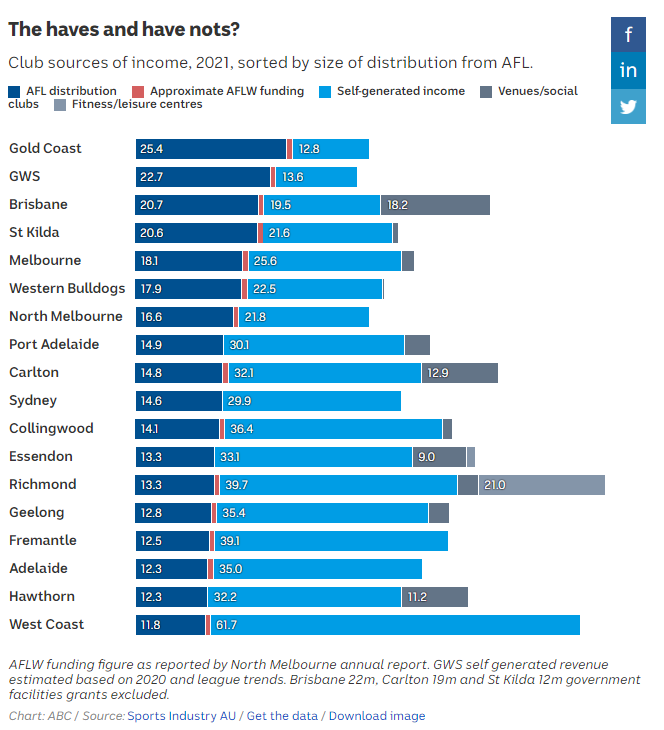
Over the past two decades, a dramatic gulf has developed between the league's haves and its have-nots.
The AFL has used its new broadcast largesse to equalise resources for needy clubs, putting them in a much-better position than they would have otherwise been.
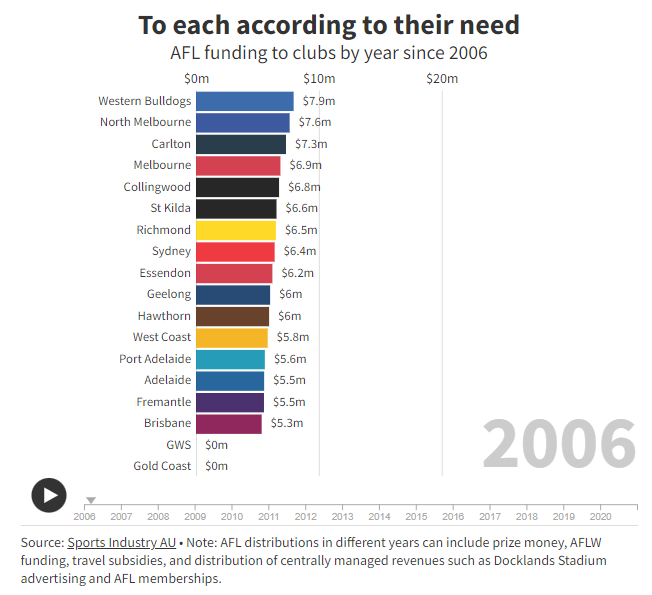
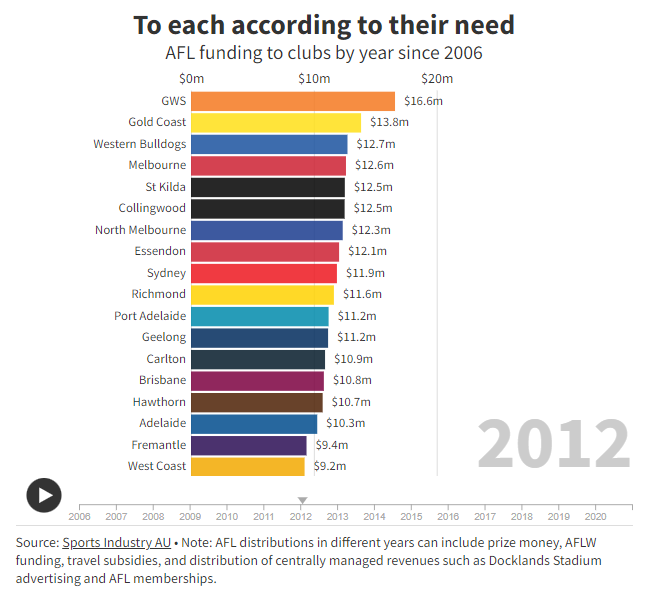
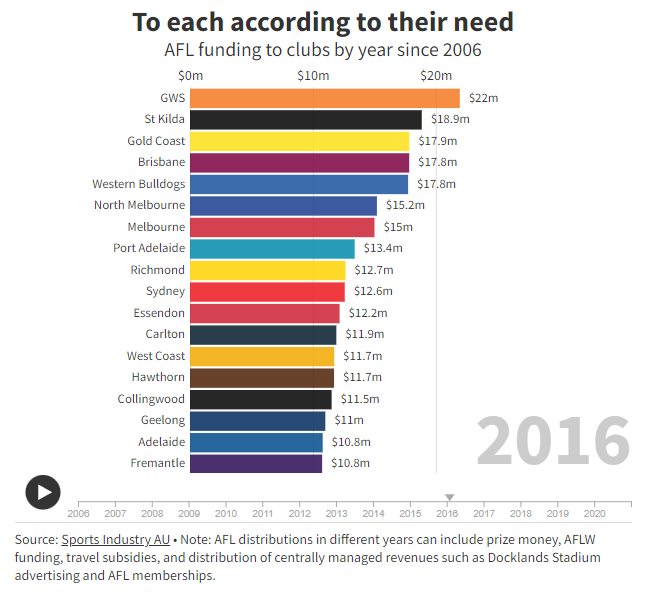
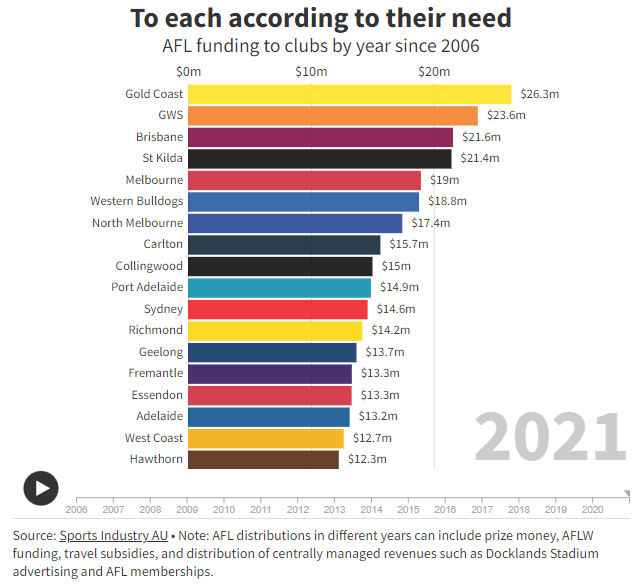
Administrators have long grappled with the question of whether the divide between rich and poor is inevitable and unavoidable.
Know your product?AFL distributions aren't the only things keeping clubs afloat. A football club is essentially a community-owned, medium-sized business. Most are as big as an average RSL club. They try to raise revenue through various means.
Some clubs diversify their income streams through pokies or public gyms.
But their biggest earner remains charging people to watch their teams play football. Clubs sell tickets and merchandise to their fans, and charge sponsors to promote their products and services.
Some fans and pundits cite lack of exposure as a reason that smaller clubs are not as financially well-off.
The perception is that clubs with the marquee fixtures draw in more money because of when and where they get to play.
But how much of an impact does that really have?
Tony Corke — who runs the popular Matter of Stats website — has studied the impact of game times on crowd sizes for games.
"The historical data shows that the difference between a Friday night slot and a Saturday afternoon one for the same fixture might be as large as 3,500 attendees," Corke said.
"That's after you control for a host of other factors, such as who's playing, where it's being played, how close the game is expected to be, and whether or not the home team is expected to win."
ABC Sport has analysed how many blockbuster home games each club plays, and compared that to their revenue from membership and attendances.
We've classified marquee fixtures as night games on Thursday, Friday, or Saturday, as well as special public holiday matches.
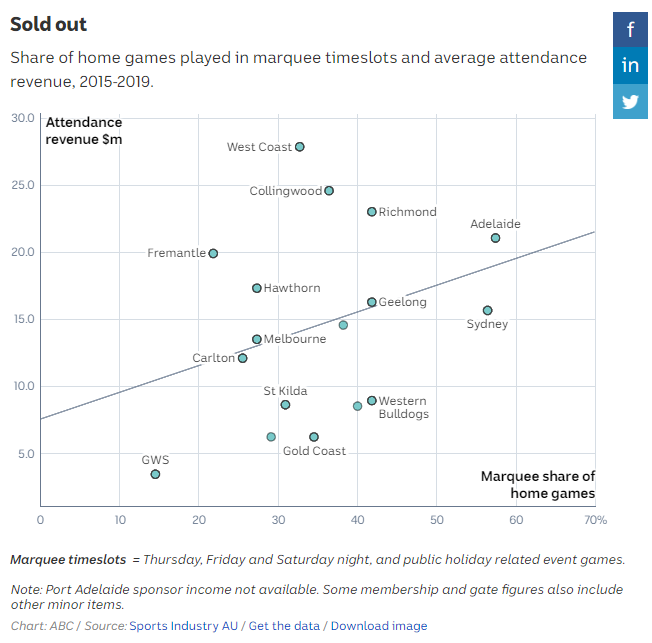
Looking across the league, the frequency of marquee timeslots has some relationship with overall attendance income for each club.
This is mostly because club fanbases vary a lot in size.
Where fixture scheduling can have an even bigger impact, however, is dictating whether a club's crowds will reach their full potential.
This is most significantly an issue in Victoria, where there are 10 teams and multiple games played every week.
In a crowded market, there's little doubt that bad timeslots can suppress attendances and hurt the clubs' bottom lines.
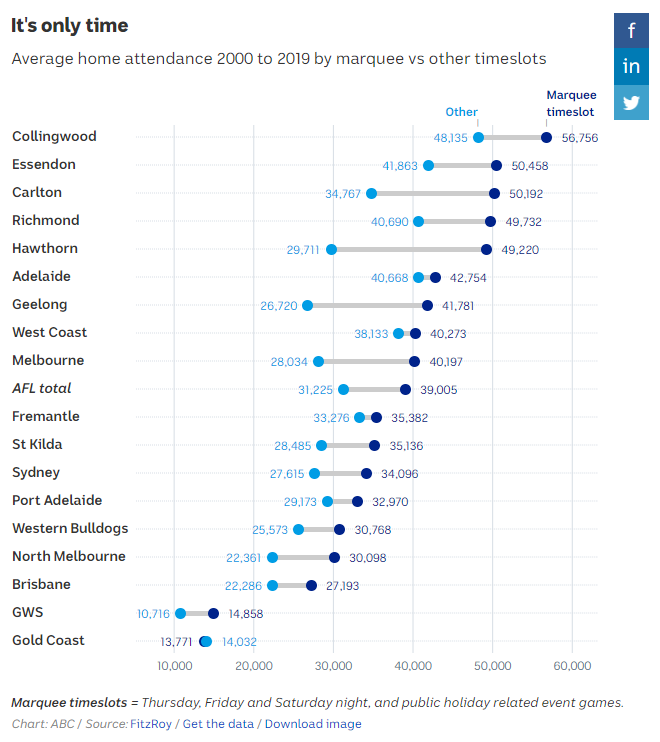
About a third of AFL games are played in the marquee timeslots. Generally, they draw 25 per cent more attendees than the remaining two thirds of matches. And, again, the effect is most-clearly seen in Victoria.
Elsewhere, the market is a bit different. The teams based in Adelaide and Perth pack their member-filled stadia, regardless of when their games are played, which is part of the reason why they're rarely given Friday night fixtures.
Some NSW and Queensland clubs often prefer family-friendly earlier timeslots, with Gold Coast not seeing any crowd premium from the night games they play at Carrara.
No, your productAttendance figures are only one part of the equation, with most live sport consumed via broadcast.
Media exposure can be hugely valuable to footy clubs, due to the money they can generate through sponsorship.
Sponsors pay a lot of money to get in front of footy fans. Their logos are displayed on guernseys, websites and emails, stadium signage, at press conferences, and anywhere else they'll fit.
And sponsors expect those logos to be seen as often and as widely as possible. The best way to ensure that is to sponsor a team with a high profile.
Research from Jason Lassey — of the website Sports Industry AU — shows that the time a game is played will have a huge impact on how many people watch it.
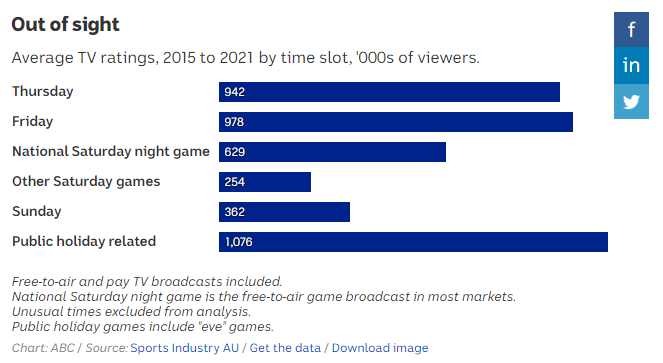
There's a loose relationship across the AFL between broadcast audience and the amount of corporate income being earned by clubs. More exposure can greatly improve a team's financial position.
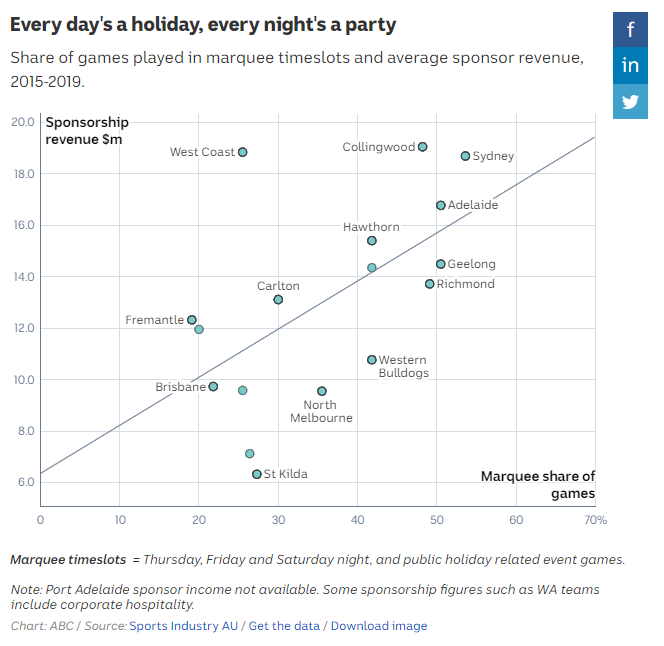
There are exceptions, notably in the corporate-friendly cities of Perth and Sydney.
The Eagles take in many millions in corporate funding in resource-rich Western Australia, despite rarely receiving national television exposure.
In the nation's financial hub of Sydney, even the ironically named Giants have found sponsorship dollars relatively easy to come by, out-earning several more widely-watched and supported teams.
By and large, though, it's the usual heavyweights with large fanbases that make the biggest sponsorship deals.
Everything's fineWhile popular teams enjoy even more exposure by playing in the best timeslots, smaller clubs can struggle for airtime.
This likely perpetuates existing revenue inequalities, making the rich richer, and poor poorer.
Fewer fans attend games in bad timeslots, especially in Melbourne, and the sponsors aren't keen for Sunday afternoon games that are limited to pay-TV.
Sharing around the marquee spots would likely reduce the direct income gap by boosting revenue streams for smaller clubs and lowering them for the heavyweights.
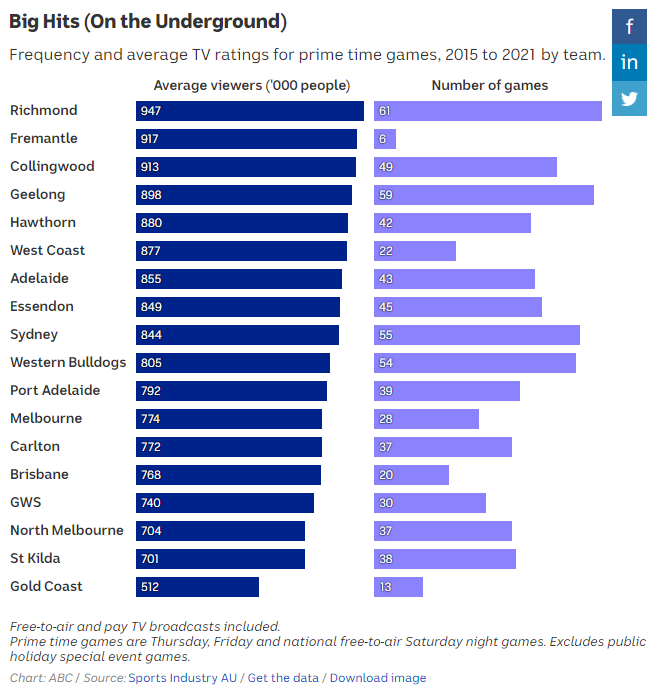
The flip side is that putting the better-supported clubs in better timeslots increases the league's overall viewership, growing the total revenue pie to be shared.
The solution to the problem isn't simple, if it even is a problem at all.
One-way streetThere's also more to audience share than just having the best timeslot. The size of a club's fanbase is a very real constraint on how much cash it can generate.

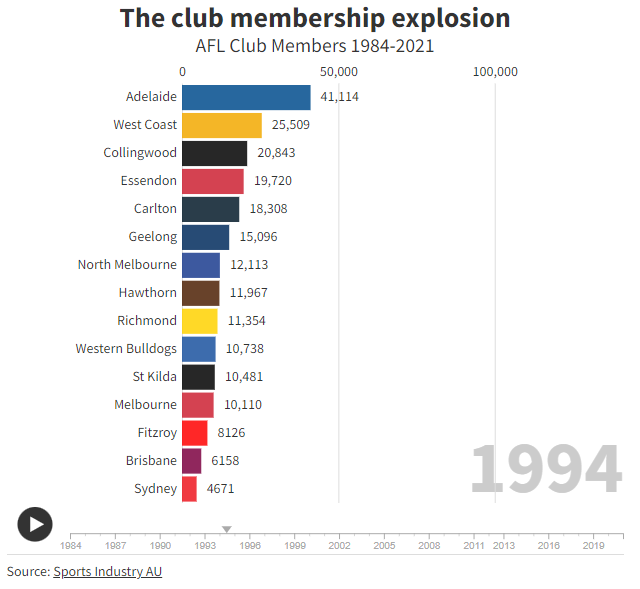
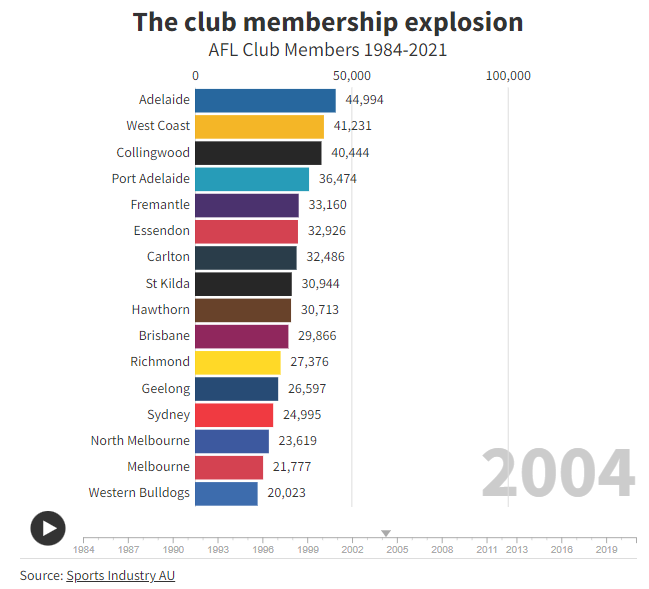
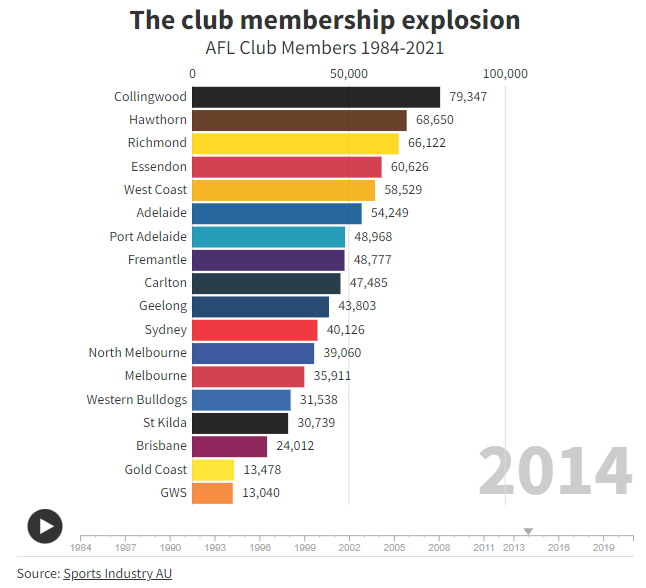
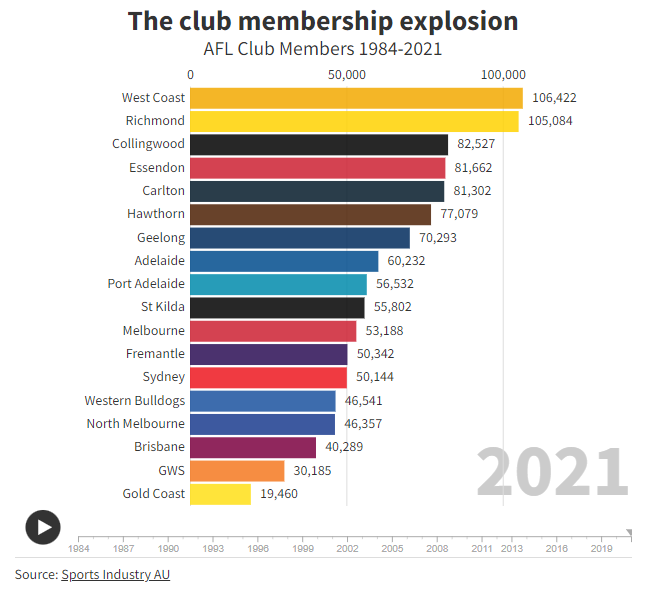
While good on-field performances can provide a short-term sugar hit to a club's finances, it can take generations of work to truly boost or diminish a club's standing in the market.
Geelong expressed this reality in a 2013 written submission to the AFL on equalisation:
"Over half of supporters follow their parent's team. There is little evidence that the relative size of supporter bases has moved much between clubs over the last 50 years.
A few clubs may have lost a little ground after decades of poor performance and arguably only one club has gained due to a level of sustained on-field success 30 years ago that cannot be repeated."
As the AFL keeps up its on-field equalisation initiatives to share talent around the league, such as the salary cap and the draft, it must also ensure off-field balance.
That can mean pumping up the broadcast revenue by exploiting the popularity of certain teams, then sharing the resulting money so that all teams can compete fairly.
The AFL is, after all, only as strong as it can keep all its clubs.
https://www.abc.net.au/news/2022-04-14/are-afl-clubs-getting-a-fair-deal-off-field-finances-money-footy/100987862